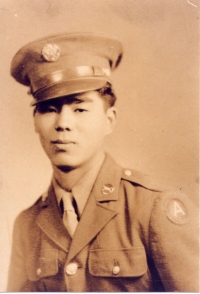This story is my personal recollection of my experiences in the Anzio Beachhead…
I was one of 287 officers and enlisted men in the 2nd replacement group sent from Camp Shelby to join the 100th Infantry Battalion. I was attached to B Company; and I received only two days of training in combat situation with the ‘old timers’ before the 100th was sent to the front line area along the Mussolini Canal and relieved the battalion of the 34th Infantry Division. This area was pockmarked with shell holes as the German artillery had shelled the area constantly. Absolutely no activity was allowed during daylight hours. Every man had to remain in farmhouses or dugouts in the back of shelled-out houses. Even toilet ‘duties’ had to wait until after dark as the German artillery was positioned on the high ground surrounding the Mussolini Canal and farmlands and every movement, even a lone soldier, if spotted, would invite a barrage from the deadly 88mm rifles.
After sunset, the ‘beach rats,’ as we were called, became alive. Every squad was assigned duties. Our first night duty was to bury dead German soldiers who were killed in action during attacks against the 34th Div. element, two or three weeks prior to our arrival. Several bodies had not been recovered when the Germans retreated and the stench was unbearable. Other duties consisted of patrols, manning listening posts, picking up supplies and water from the rear, manning machine guns along the canal wall, occupying foxholes on the front line 24 hours at a time. During free time, some would pick watercress along the shallow parts of the canal so there was no shortage of fresh vegetables. Occasionally, cows would get shot ‘accidentally’ behind the line and when that happened, word got around fast and guys from other platoons equipped with sharp knives did not waste any time helping themselves to parts of the cow which they took back to their squads.
One night around the middle of May, our platoon sergeant told our squad leader that our squad was assigned to capture prisoners. That was scary because we had no idea how we could sneak up on them, much less capture them, while they were in their highest state of alert. But being paid for a hazardous job, we had no choice in the matter. Our platoon sergeant wanted to lead and squad himself but he was overruled. We were briefed by the C.O. himself: ‘Leave you wallet and anything else that will identify you other than dog tags taped together; only one bandolier of M1 ammo and no cartridge belt or anything that rattles; if you’re fired upon, return; if wounded, try and make it back on your own because we may not be able to go and get you; if captured, you know your code of conduct for POWs’ So with that briefing, nine of us set out past the front line and crawled most of the way on our bellies as we had only an inkling where we would find a German outpost. After what seemed like hours, we came to a stop when we heard clicking sounds like someone was cocking a machine gun. All of a sudden, it happened; tracers flying all around and over our heads; four or five potato mashers (German hand grenades) were tossed at us but only one actually hit their target–our squad leader’s face–and bounded off before exploding about five feet away. Incredibly, no one was injured–only the one black & blue face. Of course, we withdrew as we were ordered to do. When we returned to the line, no one had expected to see us back.
The following night, Capt. Young Oak Kim volunteered to bring back prisoners and took Sgt. Irving Akahoshi, several riflemen and a BAR man to cover just in case, and, of course, they were successful and brought back two prisoners. Dr. Thomas Murphy’s Ambassadors in Arms’ and several other books describe the cunning moves by the legendary captain in capturing those prisoners. As for the failed mission, nothing was written or mentioned in battalion journals or anywhere else about the 1st squad, 3rd platoon of Company B, which was nearly clobbered in the tall grass in no man’s land of Anzio Beachhead.
My “adventure” took me to Camp Shelby, Anzio where I joined the 100th Battalion, Belvedere, the PO Valley, Bruyeres/Biffontaine in France’s Vosges Mountain, to Southern France (Champagne Campaign), and back to Italy to fight in the Gothic Line (Rocky Ridge). Of all the combat situations I was in, two battles come to mind:
On June 26, 1944, my squad of four was assigned the mission of securing an enemy house outside of Belvedere, Italy. We maneuvered around the building and captured it after hard fighting; and we captured 17 and wounded 7 of the enemy, and took 13 enemy amphibious jeeps, four machine guns, five machine pistols and numerous rifles. This successful mission was instrumental in controlling the highway and cutting the route of escape of all enemy vehicles in the vicinity.
On April 14, 1945, our rifle company was given the mission of defending the left flank of an infantry battalion protecting the town of Castelpoggio against an enemy counterattack. While our 3rd Platoon was defending the town, we were charged by a group of enemy troops, firing bursts of automatic weapons fire. We stood our ground and returned fire, killing 3 and wounding one of the foe, and silencing an enemy machine gun and repelling the enemy. Sadly, we lost a platoon member in this operation.
Rikio recorded these experiences in 2009.

